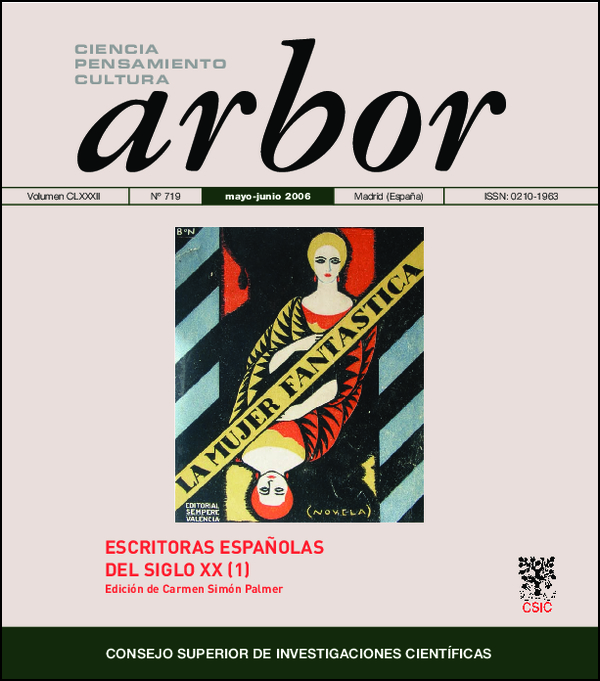“Tenía corazón”: Dulce dueño de Emilia Pardo Bazán
DOI:
https://doi.org/10.3989/arbor.2006.i719.33Keywords:
Emilia Pardo Bazán, Dulce Dueño, FeminismoAbstract
This article explores Pardo Bazán´s dialogue with realist representational fiction, with its voyeuristic obsessions, by revisiting certain passages in the novel Dulce Dueño and reviewing recent feminist scholarship (Bieder, Bacon, Medina and Kirkpatrick) that sees the novel to varying degrees as subversive of the male gaze. While these critics correctly see the novel as gesturing towards modernity, this article examines also its backward glance at earlier woman-plots in relation to feminine subjectivity that imagine various ways to demonstrate that woman tenía corazón.
Downloads
References
Bacon, K. (2005): “Death and the Virgin Martyr: Re-Writing Hagiography in Dulce dueño.” Forum of Modern Language Studies. 41.4. Oxford: Oxford University Press, 375-385.
Balzac, H. de (2002): Cousin Bette. Trad. Kathleen Raine. Intro. Francine Prose. New York: Modern Library.
Benjamin, J. (1998): Shadow of the Other. Intersubjectivity and Gender in psychoanalysis. New York: Routledge.
Berger, J. (1977). Ways of Seeing. London: Penguin Books.
Bieder, M. (2002): “Contesting the Body: Gender, Language, and Sexuality. The Modern Woman at the Turn of the Century.” En Women’s Narrative and Film in Twentieth Century Spain: A World of Difference(s), Ed. Ofelia Ferrán y Kathleen Glenn. New York y London: Hispanic Issues 27. Garland/ Taylor and Francis. 3-18.
Bieder, M. (2000): “Divina y perversa: La mujer decadente en Dulce Dueño de Emilia Pardo Bazán.” En Perversas y divinas. La representación de la mujer en las literaturas hispánicas. El fin de siglo/o el fin de milenio actual. Ed. Carme Riera, Meri Torras e Isabel Clúa. Barcelona: Universitat Autónoma de Barcelona. 8-19.
Charnon-Deutsch, L. (2000): Fictions of the Feminine in the Nineteenth-Century Spanish Press. College Park, Pennsylvania: Penn State Press.
Clèmessy, N. (1981): Emilia Pardo Bazán como novelista. Vol I. De la teoría a la práctica. Trad. Irene Gambra. Madrid: Fundación Universitaria Española. Eliot, G. (1999): Daniel Deronda. London: Everyman.
Kirkpatrick, S. (1999): “Gender and modernist Discourse: Emilia Pardo Bazán’s Dulce dueño.” En Modernism and its Margins: Reinscribing Cultural Modernity from Spain and Latin America. Ed. A. L. Geist y J. B. Monleón. New York y London: Garland Reference Library of the Humanities. 69-82.
Kristeva, J. (1987): Tales of Love. Trad. Leon S. Roudiez. New York: Columbia University Press.
La Belle, J. (1988): Herself Beheld. The Literature of the LookingGlass. Ithaca: Cornell University Press.
Marantz Cohen, P. (1991): The Daughter’s Dilemma: Family Process and the Nineteenth- CenturyDomestic Novel. Ann Arbor: University of Michigan Press.
Medina, R (1998): “Dulce esclava, dulce histérica: La representación de la mujer en Dulce Dueño de Emilia Pardo Bazán.” Revista Hispánica Moderna 51, 291-303.
Mayoral, M. (1989): Intro. Ed.: Dulce Dueño. Madrid: Castalia. 7-44.
Pardo Bazán, E. (1989): Dulce Dueño. Ed. Marina Mayoral. Madrid: Castalia.
Pardo Bazán, E. (1973) “Santa Catalina de Alejandría. Virgen y mártir.” En Obras Completas. II. Ed. Federico Carlos Sainz de Robles. Madrid: Castalia (3a edición).
Valle Inclán. R. (1961): Sonata de estío. Obras escogidas. Prol. Gaspar Gómez de la Serna. Madrid: Aguilar.
Downloads
Published
How to Cite
Issue
Section
License
Copyright (c) 2006 Consejo Superior de Investigaciones Científicas (CSIC)

This work is licensed under a Creative Commons Attribution 4.0 International License.
© CSIC. Manuscripts published in both the printed and online versions of this Journal are the property of Consejo Superior de Investigaciones Científicas, and quoting this source is a requirement for any partial or full reproduction.
All contents of this electronic edition, except where otherwise noted, are distributed under a “Creative Commons Attribution 4.0 International” (CC BY 4.0) License. You may read the basic information and the legal text of the license. The indication of the CC BY 4.0 License must be expressly stated in this way when necessary.
Self-archiving in repositories, personal webpages or similar, of any version other than the published by the Editor, is not allowed.














